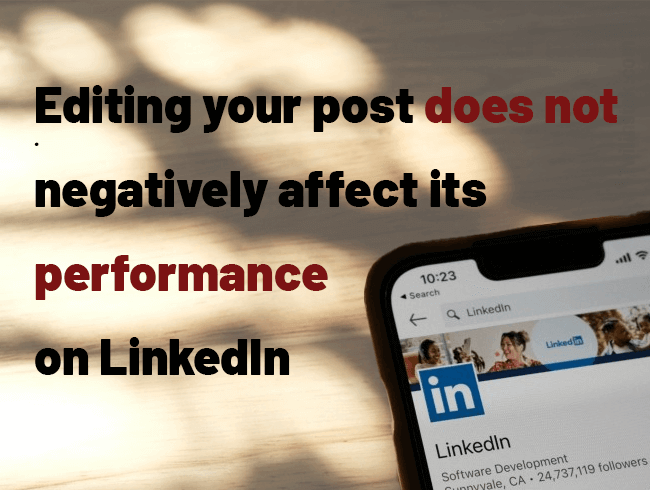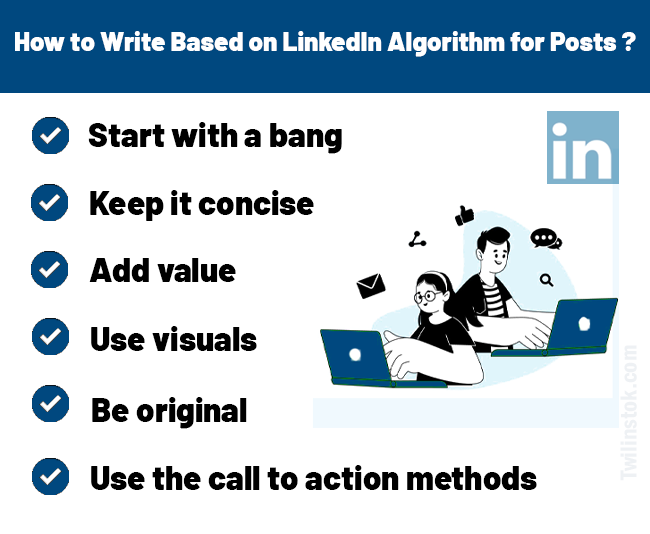LinkedIn Algorithm for Posts: How to Write for LinkedIn Posts
Rules for LinkedIn Posts
We’ve heard that you’re interested in LinkedIn posts, huh? Well, you’ve searched the right keyword and found the right article! Let’s chat a bit about this thing called the LinkedIn algorithm for Posts. It’s not as scary as it sounds so let’s dive in!
When you post something on LinkedIn, this algorithm is like a little digital helper that decides who gets to see your post and when. It’s like the director of a movie, deciding which scenes make the final cut.
Now, why should you care about this? Well, if you understand how this algorithm works, you can make sure your posts get seen by more people. It’s like knowing the best time to hit the stage when the audience is at its largest. Stick with us in this article from Twilinstok and learn all the secrets!
Understanding the LinkedIn Algorithm for Posts
Alright, let’s dive into the LinkedIn algorithm for Posts. Picture it like a behind-the-scenes crew, working hard to make sure the right posts get to the right people at the right time.
But here’s the kicker: the LinkedIn algorithm for Posts is always learning and changing. That’s right, it’s a bit of a shape-shifter. As people’s behaviors on LinkedIn change, so does the algorithm. It’s constantly trying to provide the most relevant content to each user.
LinkedIn Algorithm and Editing Posts
So, you’ve crafted a LinkedIn post, hit the ‘Post’ button, and then…oops! You spot a typo. Or maybe you’ve thought of a better way to phrase something. No worries, it happens to the best of us! But here’s the question: if you edit your post, will it affect how the LinkedIn algorithm treats it?
Well, let’s spill the beans. In the past, some rumors editing a LinkedIn post could cause it to be ‘downgraded’ by the algorithm, meaning it would reach fewer people. But guess what? LinkedIn itself has debunked this myth. That’s right, editing your post does not negatively impact its performance. Phew!
However, there’s a catch. While the LinkedIn algorithm for Posts doesn’t penalize edited posts, your audience might. If you’re constantly editing your posts after publishing, your followers might start to find it a bit annoying. Plus, each edit is a chance for a mistake, and too many mistakes might harm your credibility.

LinkedIn Specs for Posts
Now that we’ve got the algorithm and editing posts down, let’s talk about the specs for LinkedIn posts. You know, all the little details that can make a big difference in how your post looks and performs.
- First off, let’s talk about text. LinkedIn allows you to write a post with up to 1300 characters. That’s about 200 words, give or take. It might not seem like a lot, but trust me, you can say a lot in 200 words!
- Next up, images. If you’re adding a picture to your post, LinkedIn recommends an aspect ratio of 1.91:1. And the maximum file size? 5MB. So, make sure your images are clear, but not too heavy!
- And what about videos? LinkedIn supports videos up to 10 minutes long, but the sweet spot is usually between 30 seconds to 5 minutes. The file size limitation in LinkedIn is 5GB.
How to Write Based on LinkedIn Algorithm for Posts?
Alright, we’ve covered the LinkedIn algorithm for Posts spec. Now, let’s get to the fun part: writing your LinkedIn posts!
Writing for LinkedIn is a bit like crafting a mini-speech. You want to grab attention, deliver value, and spark a conversation. But how do you do that? Well, here are some tips:
- Start with a bang: Your first line should hook your reader in.
- Keep it concise: Remember, you’ve got 1300 characters.
- Add value: Share insights, provide tips, or ask thought-provoking questions.
- Use the call to action methods: Motivate your audience to engage.
- Use visuals: A relevant image or video can make your post stand out and drive more engagement.
- Be original: Let your qualities shine through your content. LinkedIn is a professional network, but that doesn’t mean you have to be formal all the time. Be human, be you!
Rules are there to guide you, not to limit you. Don’t be afraid to experiment and see what works best for you and your audience. After all, every audience is unique.

LinkedIn Post Examples
Now that we’ve covered the basics of the LinkedIn algorithm for Posts, let’s look at some examples of LinkedIn posts that hit the mark. Remember, these are just examples. Your posts should be unique to you and your audience. But, they might give you some inspiration!
- The Thought Leader: This post starts with a thought-provoking question, shares some unique insights, and ends with a call to action asking readers to share their thoughts.
- The Celebrator: This post shares a personal accomplishment or milestone. It’s authentic, relatable, and inspires others.
- The Storyteller: These kinds of posts share a personal story or experience which can be engaging, and human, and create an emotional connection with those who follow you.
- The Educator: This post shares a useful tip or piece of advice. It’s helpful, adds value, and positions you as an expert in your field.
- The Networker: This post tags other professionals or gives a shout-out to someone in your network.
Using AI to Write LinkedIn Posts
Welcome to the future, where AI can help you write your LinkedIn posts! Sounds pretty cool, right? But how does it work? Let’s dive in.
AI is a high-tech artificial brain that can learn and make decisions. In the context of writing LinkedIn posts, AI can help you craft engaging, relevant content that resonates with your audience. It can suggest topics, help with phrasing, and even check your grammar!
But wait, there’s more! AI can also analyze data to determine the best time to post, the most effective hashtags to use, and even predict how well your post will perform. It’s like having your very own digital marketing assistant!
Now, you might be thinking, “But I don’t want my posts to sound like they were written by a robot!” Don’t worry, AI has come a long way. Today’s AI can write in a way that’s indistinguishable from a human. You might have already read AI-written content without even realizing it!
How LinkedIn Algorithm Works: LinkedIn Algorithm Report Explained
LinkedIn Algorithm For Business: Maximizing Growth Strategies
Last words on LinkedIn algorithm for Posts
And there you have it, folks! We’ve journeyed through the world of LinkedIn algorithm for Posts, from understanding the mysterious LinkedIn algorithm to crafting posts that resonate with your audience. We’ve debunked myths, shared tips, and even explored how AI can lend a helping hand.
Don’t be afraid to let your personality shine through and remember, authenticity is key. After all, it’s your unique insights and experiences that make your posts truly yours. So go ahead, and start crafting your LinkedIn posts with confidence and creativity. Happy posting, and here’s to making your mark on LinkedIn!
That’s all for now, but stay tuned for more tips and tricks on mastering the art of LinkedIn algorithm for Posts. Until next time, keep sharing, learning, and being original!
For more information about LinkedIn and the features of this social network, we suggest that you click on Free LinkedIn Tutorial [+]. Also, if you have any questions about LinkedIn, you can ask them in our LinkedIn Help Center [+] in the form of a topic and wait for the answers from our experts.
FAQs:
What does the LinkedIn algorithm for posts do?
It’s a system that LinkedIn uses to decide which posts to show in a user’s feed, based on how likely they are to interact with the post.
How does the LinkedIn algorithm for posts operate?
Initially, it verifies whether your post is spam or of good quality.
What’s the purpose of the LinkedIn algorithm for posts?
Its primary objective is to present users with pertinent, high-quality content that stimulates engagement.
Is it possible for posts to go viral on LinkedIn?
LinkedIn isn’t typically a platform for viral content. It’s more about disseminating valuable information and updates to those who will find it useful for their career advancement.
What’s a crucial strategy for optimizing the LinkedIn algorithm for posts?
A key tactic is to cultivate a network of professionals in your industry.

